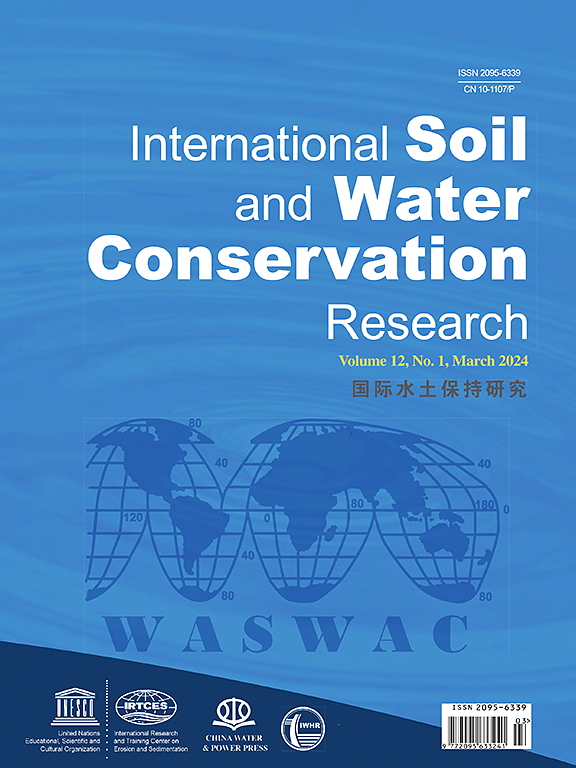Predictive performance and uncertainty analysis of ensemble models in gully erosion susceptibility assessment
IF 7.3
1区 农林科学
Q1 ENVIRONMENTAL SCIENCES
International Soil and Water Conservation Research
Pub Date : 2025-01-25
DOI:10.1016/j.iswcr.2025.01.004
引用次数: 0
Abstract
Gully erosion, as a significant natural process in geomorphological evolution, poses serious threats to natural environments and socio-economic stability. In response, Gully Erosion Susceptibility Maps (GESMs) have become essential references for effective watershed management. This study aims to identify the optimal feature datasets and to quantify the uncertainty associated with gully erosion prediction models by developing a novel methodological framework based on ensembles of the three machine learning models: Random Forest (RF), Convolutional Neural Network (CNN), and Transformer models. This study area is the Tuquan watershed in Inner Mongolia, China. A total of 25 Geo-Environmental Factors (GEFs) were selected to build datasets, supplemented by a gully inventory map comprising 823 gullies, resulting in 12,946 samples of both gully and non-gully occurrences. 3 ensemble methods including probability mean (PM), Probability Weighted Mean (PWM), and Probability Empirical Weighted Mean (PEWM) were used. Subsequently, the datasets underwent multi-collinearity testing before model computations. The optimal feature datasets S7 included factors such as the Convergence Index (CI), Topographic Wetness Index (TWI), Terrain Ruggedness Index (TRI), distance from river, annual rainfall, distance from road, drainage density, elevation, Normalized Difference Vegetation Index NDVI, slope, and Slope Length (LS). The ensemble model Transformer-RF-CNN employing PEWM demonstrated superior performance, validated by 10-fold cross-validation and 8 metrics: Efficiency (E), True Positive Rate (TPR), False Positive Rate (FPR), True Skill Statistics (TSS), Kappa coefficient (K), Area Under the receiver operating characteristic Curve (AUC), Root Mean Square Error (RMSE), and Mean Absolute Error (MAE). The uncertainty associated with GESMs was quantified using the Coefficient of Variation (CV) map, resulting in a confidence map that classified 20 zones, with 75.976% of gullies located in high-susceptibility and low-uncertainty areas. This study provides critical insights for regulators and decision-makers, facilitating more informed planning for gully erosion prevention and control.
集合模型在沟道侵蚀敏感性评价中的预测性能及不确定性分析
沟蚀是地貌演化过程中一个重要的自然过程,对自然环境和社会经济稳定构成严重威胁。因此,沟壑区侵蚀敏感性图(GESMs)已成为有效流域管理的重要参考。本研究旨在通过开发一种基于随机森林(RF)、卷积神经网络(CNN)和变压器模型这三种机器学习模型的集成的新方法框架,确定最佳特征数据集,并量化与沟蚀预测模型相关的不确定性。本研究区为内蒙古土泉流域。共选取25个地理环境因子(gef)构建数据集,并辅以包含823个沟壑的沟壑清查图,共获得12946个沟壑和非沟壑发生地样本。采用概率均值(PM)、概率加权均值(PWM)和概率经验加权均值(PEWM) 3种集成方法。随后,在模型计算之前,对数据集进行多重共线性检验。最优特征数据集S7包括收敛指数(CI)、地形湿度指数(TWI)、地形崎岖指数(TRI)、与河流的距离、年降雨量、与道路的距离、排水密度、高程、归一化植被指数NDVI、坡度和坡度长度(LS)等因子。采用PEWM的集成模型Transformer-RF-CNN表现出卓越的性能,通过10倍交叉验证和8个指标验证:效率(E)、真阳性率(TPR)、假阳性率(FPR)、真技能统计(TSS)、Kappa系数(K)、接收者工作特征曲线下面积(AUC)、均方根误差(RMSE)和平均绝对误差(MAE)。利用变异系数(CV)图对与GESMs相关的不确定性进行量化,得到20个区域的置信度图,其中75.976%的沟槽位于高敏感性和低不确定性区域。该研究为管理者和决策者提供了重要的见解,促进了更明智的沟蚀防治规划。
本文章由计算机程序翻译,如有差异,请以英文原文为准。
求助全文
约1分钟内获得全文
求助全文
来源期刊

International Soil and Water Conservation Research
Agricultural and Biological Sciences-Agronomy and Crop Science
CiteScore
12.00
自引率
3.10%
发文量
171
审稿时长
49 days
期刊介绍:
The International Soil and Water Conservation Research (ISWCR), the official journal of World Association of Soil and Water Conservation (WASWAC) http://www.waswac.org, is a multidisciplinary journal of soil and water conservation research, practice, policy, and perspectives. It aims to disseminate new knowledge and promote the practice of soil and water conservation.
The scope of International Soil and Water Conservation Research includes research, strategies, and technologies for prediction, prevention, and protection of soil and water resources. It deals with identification, characterization, and modeling; dynamic monitoring and evaluation; assessment and management of conservation practice and creation and implementation of quality standards.
Examples of appropriate topical areas include (but are not limited to):
• Conservation models, tools, and technologies
• Conservation agricultural
• Soil health resources, indicators, assessment, and management
• Land degradation
• Sustainable development
• Soil erosion and its control
• Soil erosion processes
• Water resources assessment and management
• Watershed management
• Soil erosion models
• Literature review on topics related soil and water conservation research
 求助内容:
求助内容: 应助结果提醒方式:
应助结果提醒方式:


